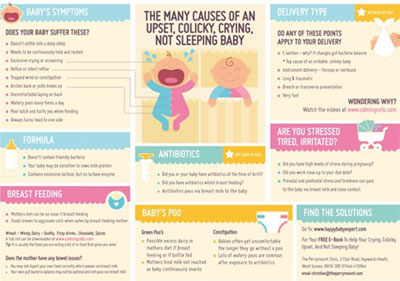
How Calming Colic came to be written
This is just a little background on how I ended up writing Calming Colic.
I have been treating babies using cranial osteopathy since I first graduated osteopathy college in 1997. I quickly learnt that remaining calm around a crying baby was one of the best ways to help that baby calm down. The first baby I ever treated didn’t calm down at all as my nervous, shaky hands cradled their head! I also caught chicken pox off them at 22 years of age, which was unpleasant to say the least, especially as I had just bought my second ever car and wanted to drive around town in it. I actually looked like a zombie so I didn’t go out in fear of scaring people.
As I treated more and more babies over the last 15 years I started to see patterns emerging in the causes behind babies colic and from these I developed my own treatment protocols. These patterns became more obvious to me as I simply treated more babies and was mentally collecting data. Because I had so much information to give to parents in their first consultation with me I wrote a handout for them as they simply couldn’t remember everything I told them. Not surprising really considering they are tired parents with a colicky newborn. So I wrote a handout explaining what I had told them and a list of foods for the mother to avoid etc.
But I wanted the handout to be better than that. I wanted it scientifically referenced. Parents are understandable protective over their new baby and I wanted them to rest assured that what I was recommending them to do had scientific back up and also it was only advice I would and had done on my own two children. For example, when breast feeding finished for my two boys they then exclusively used Nanny Goat’s milk formula.
I also wanted the parents to be able to show their midwife or health visitor my handout so they also knew that what I was recommending was scientifically based. Calming Colic is basically an expansion of what started out as the “handout”. I just became more and more excited over the research I was finding to back up the causes I saw in clinic behind colic. I remember finding research that proved what I was suspected and was seeing in clinic and having no one to tell about it. I don’t know anyone who is as interested in colic as me!
Calming Colic is basically all I know about the causes behind colic, it is what I work through with parents when they come in. Except in the book I explain it more, I always think it is better to have an explanation of why something happens and why you do something to help it and that’s what I wanted to provide.
For example I could say to a parent “you should supplement yourself with a probiotic because you had an emergency c-section”. Okay … if they totally trust me then the mother will. But if I say this:
“You should supplement yourself with a probiotic because you had an emergency c-section, because scientific research has show that the stress from a unplanned emergency c-section actually lowers the good bacteria in your breast milk which you should be passing on to your baby when you breast feed. Then I hope they will feel safer taking my advice. And if they really want they can have a look in the back of Calming Colic and look up the exact reference if they like.
Now, I have big plans for Calming Colic as I wholeheartedly believe that it contains information that all parents need to know BEFORE they go into labour. In fact it would be ideal to read it before the last trimester to get the most out of it. What’s also great is that the advice is really simple, in fact many of the causes of colic are remedied by the same few approaches.
I also don’t think there is another book out there that competes with Calming Colic, firstly because it is experience based but also backed by science. Secondly, it must have a demand as the NHS openly doesn’t know what to do about colic.
This is taken directly off the NHS website after searching for information on colic:
“Colic is a common, but poorly understood, condition that affects babies. The most common symptom of colic is excessive and inconsolable crying in a baby that otherwise appears to be healthy and well-fed.”
It also says:
“The cause (or causes) of colic is unknown.”
“There is no evidence to suggest that colic has any long-term adverse effects on your baby’s health.”
“There is currently no cure for colic.”
I think after you have read Calming Colic you will change your mind about most of these statements. The NHS are fairly definitive in maintaining that you aren’t really going to be able to help your child with their colic, which might make you feel rather helpless and more than a little tired, and although colic in itself is harmless it can be very unpleasant for baby and parents when the knees-up, red-faced crying really gets going.
The line “There is no evidence to suggest that colic has any long-term adverse effects on your baby’s health” is also interesting to me. I agree with it as once the colic has gone you will forget about it in the blink of an eye as you move onto more amazing things like your baby saying “mama”, pointing, rolling over or basically just blinking! However, the reason there is no long-term evidence is probably that a long-term study hasn’t been done. I don’t know for sure that there is a long-term effect but each of the causes of colic I am going to reveal to you could potentially have some longer-lasting effect, nothing drastic mind you, but I think it would be beneficial to correct these causes now; more will become clear later. The good news is that the methods I am going to suggest to address colic will also address these longer-term effects; in fact one of the studies in the probiotic section carried out research and found benefits four years down the line.
So I am going to go against these statements as I actually think that I have developed a formula to calm colic. It may not be a magic bullet in that it works instantly, although it can be fairly quick, but it will certainly make a real, noticeable improvement.
In my years as an osteopath treating babies, the most common problems I see are colic and irritability after birth. I think, and hope, most parents are pleasantly surprised when it is not only cranial osteopathy that I use to help their precious baby. I inquire about the baby’s and mother’s diet, I ask about whether instruments were used in the delivery, whether antibiotics have been used for mother or baby, was the birth in hospital or at home? Is the mother breastfeeding, expressing, or using formula, and if so, what formula? What I am aiming to get is a broad picture about their baby’s new life so far and even about its development in the womb for the previous nine months. What I am trying to get across here is that I’m not just trying to diagnose that the baby has colic, I am looking deeper than that, to find out why the colic is there in the first place and what treatments I can do myself and advise the parents to continue at home so the pain of colic can be calmed and everyone can start to get some good sleep.
On top of this I have included in Calming Colic all of the other information I am giving parents on a daily basis regarding their own and their child’s health. This includes advice on their own diet to support themselves and their child, or on how the tired father can get back to work without falling asleep at his desk, or some basics on breastfeeding and more.
I hope this Blog has given you a background to Calming Colic which has been written, developed and researched over a number of years. I’m glad it was as I was putting new research into it up until the last day when I had to say to myself enough is enough you have to finish this!
I hope you enjoy the book, it isn’t too heavy going and I have had a mother read it in an hour or so. You can download it from Amazon here:
[templatic_button link=”http://www.amazon.co.uk/dp/B009S8ZNLG” size=”large” type=”primary”] Buy Now From Amazon [/templatic_button]
or buy a PDF or paperback version here:
https://www.calmingcolic.com/download.html
Thanks for reading





No Comments